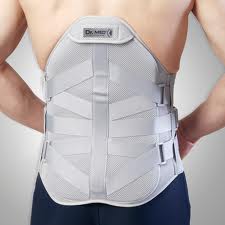Back Brace

A back brace serves as a device crafted to restrict the motion of the spine
in instances of fracture or following surgical fusions. This restriction
aids in the healing process and alleviates the patient's discomfort.
Two common types of back braces are:
1. Rigid (Hard) braces: These form-fitting plastic molds limit motion by up
to 50%.
2. Soft braces: Elastic braces that restrict forward motion of the spine and
provide support during spinal fusions or activities involving heavy lifting.
Bracing for Scoliosis
Back braces are frequently prescribed for treating adolescent idiopathic
scoliosis (AIS) to halt the progression of spinal curvature in growing
children/adolescents. In some cases, they may even reduce spinal curvature.
Various brace styles exist, with the Boston brace being the most commonly
used for AIS. Other designs include the Milwaukee brace, Charleston bending
brace, and SpineCor in the United States, Canada, and Europe.
Additionally, the SPoRT and Cheneau braces are used in Europe. Research on
back braces for scoliosis, including patient compliance, psycho-social
impact, and exercise with bracing, has been extensively published in
reputable journals. Bracing is the primary treatment for AIS in moderate
curves likely to progress, determined by curve pattern and the patient's
structural maturity.
A major issue with scoliosis bracing is patient compliance, influenced by
factors such as psycho-social comfort, exercise, ability to eat and move,
pain, and physical deformation. Back braces, particularly the Boston brace,
exert significant pressure on the abdomen, causing discomfort during
digestion. While scoliosis braces restrict motion to a large extent,
patients often struggle with tasks like tying shoes or sitting on the floor.
Bracing can also induce pain, though the body may adapt. Furthermore, braces
can deform existing bone structures, notably the hips, and occasionally the
rib cage.
undo Medical Equipment